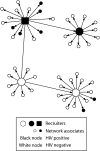Accessing social networks with high rates of undiagnosed HIV infection: The social networks demonstration project
- PMID: 19372521
- PMCID: PMC2679789
- DOI: 10.2105/AJPH.2008.139329
Accessing social networks with high rates of undiagnosed HIV infection: The social networks demonstration project
Abstract
Objectives: We evaluated the use of social networks to reach persons with undiagnosed HIV infection in ethnic minority communities and link them to medical care and HIV prevention services.
Methods: Nine community-based organizations in 7 cities received funding from the Centers for Disease Control and Prevention to enlist HIV-positive persons to refer others from their social, sexual, or drug-using networks for HIV testing; to provide HIV counseling, testing, and referral services; and to link HIV-positive and high-risk HIV-negative persons to appropriate medical care and prevention services.
Results: From October 1, 2003, to December 31, 2005, 422 recruiters referred 3172 of their peers for HIV services, of whom 177 were determined to be HIV positive; 63% of those who were HIV-positive were successfully linked to medical care and prevention services. The HIV prevalence of 5.6% among those recruited in this project was significantly higher than the approximately 1% identified in other counseling, testing, and referral sites funded by the Centers for Disease Control and Prevention.
Conclusions: This peer-driven approach is highly effective and can help programs identify persons with undiagnosed HIV infection in high-risk networks.
Figures
Comment in
-
Overstating social networks' ability to diagnose new cases of HIV.Am J Public Health. 2010 Apr 1;100 Suppl 1(Suppl 1):S5-6; author reply S6. doi: 10.2105/AJPH.2009.182998. Epub 2010 Feb 10. Am J Public Health. 2010. PMID: 20147665 Free PMC article. No abstract available.
Similar articles
-
Use of social networks to identify persons with undiagnosed HIV infection--seven U.S. cities, October 2003-September 2004.MMWR Morb Mortal Wkly Rep. 2005 Jun 24;54(24):601-5. MMWR Morb Mortal Wkly Rep. 2005. PMID: 15973240
-
HIV infection and risk, prevention, and testing behaviors among injecting drug users -- National HIV Behavioral Surveillance System, 20 U.S. cities, 2009.MMWR Surveill Summ. 2014 Jul 4;63(6):1-51. MMWR Surveill Summ. 2014. PMID: 24990587
-
Provision of HIV counseling and testing services at five community-based organizations among young men of color who have sex with men.AIDS Behav. 2011 May;15(4):743-50. doi: 10.1007/s10461-010-9821-x. AIDS Behav. 2011. PMID: 20945158
-
Respondent-driven sampling for identification of HIV- and HCV-infected people who inject drugs and men who have sex with men in India: A cross-sectional, community-based analysis.PLoS Med. 2017 Nov 28;14(11):e1002460. doi: 10.1371/journal.pmed.1002460. eCollection 2017 Nov. PLoS Med. 2017. PMID: 29182638 Free PMC article.
-
Acceptability of Peer-Delivered HIV Testing and Counselling Among Men Who Have Sex with Men (MSM) and Transgender Women (TW) in Myanmar.AIDS Behav. 2018 Aug;22(8):2426-2434. doi: 10.1007/s10461-017-2022-0. AIDS Behav. 2018. PMID: 29427231
Cited by
-
A network intervention that locates and intervenes with recently HIV-infected persons: The Transmission Reduction Intervention Project (TRIP).Sci Rep. 2016 Dec 5;6:38100. doi: 10.1038/srep38100. Sci Rep. 2016. PMID: 27917890 Free PMC article.
-
Operational research to improve HIV prevention in the United States.J Acquir Immune Defic Syndr. 2012 Apr 15;59(5):530-6. doi: 10.1097/QAI.0b013e3182479077. J Acquir Immune Defic Syndr. 2012. PMID: 22217681 Free PMC article.
-
Monetary incentives and peer referral in promoting secondary distribution of HIV self-testing among men who have sex with men in China: A randomized controlled trial.PLoS Med. 2022 Feb 14;19(2):e1003928. doi: 10.1371/journal.pmed.1003928. eCollection 2022 Feb. PLoS Med. 2022. PMID: 35157727 Free PMC article. Clinical Trial.
-
An assessment of the feasibility and acceptability of a friendship-based social network recruitment strategy to screen at-risk African American and Hispanic/Latina young women for HIV infection.JAMA Pediatr. 2013 Mar 1;167(3):289-96. doi: 10.1001/2013.jamapediatrics.398. JAMA Pediatr. 2013. PMID: 23338776 Free PMC article.
-
Recruiting the social contacts of patients with STI for HIV screening in Lilongwe, Malawi: process evaluation and assessment of acceptability.Sex Transm Infect. 2016 Dec;92(8):587-592. doi: 10.1136/sextrans-2015-052496. Epub 2016 May 13. Sex Transm Infect. 2016. PMID: 27177775 Free PMC article.
References
-
- Glynn K, Rhodes P. Estimated HIV prevalence in the United States at the end of 2003. Paper presented at: National HIV Prevention Conference; June 12–15, 2005; Atlanta, GA: Abstract T1-B1101
-
- Marks G, Crepaz N, Janssen RS. Estimating sexual transmission of HIV from persons aware and unaware they are infected with the virus in the United States. AIDS 2006;20(10):1447–1450 - PubMed
-
- Marks G, Crepaz N, Senterfitt JW, Janssen RS. Meta-analysis of high-risk sexual behavior in persons aware and unaware they are infected with HIV in the United States: implications for HIV prevention programs. J Acquir Immune Defic Syndr 2005;39:446–453 - PubMed
-
- Golden MR, Hodgen M, Potterat JJ, Handsfield HH. HIV partner notification in the United States: a national survey of program coverage and outcomes. Sex Transm Dis 2004;31:709–712 - PubMed
-
- Glynn K, Harris N. Estimates of out of care: background and methods for CDC estimate. Presented at: HRSA Engaging in Care Consultation; April 27, 2005Washington, DC
Publication types
MeSH terms
Grants and funding
LinkOut - more resources
Full Text Sources
Medical



